Note: Information will be updated for spring 2026. Information on this site is subject to change.
The International UAS Exam is a joint digital entrance exam of the Finnish Universities of Applied Sciences (UAS), used for selecting students to study programmes leading to a bachelor’s degree and conducted in English. The entrance exam is completed by the applicant’s own computer remotely online.
The International UAS Exam is organised on 24 March 2026 from 12:00 o’clock noon onwards (Finnish time, UTC/GMT+2). In the International UAS Exam, the applicants’ readiness for UAS studies is assessed. The exam does not include any advance reading materials or pre-assignments.
The International UAS Exam is used in the following study fields:
- Humanities and Education
- Business Administration, Business Information Technology (BIT)
- Natural Resources
- Tourism and Hospitality
- Seafaring
- Social Services, Health Care, Sports and Exercise, Beauty Care
- Technology
Please check in Table 1 (will be updated) whether your targeted study programmes use the International UAS Exam. If your targeted study programme does not use the International UAS Exam, please refer to Studyinfo.fi for more information on the programme and admission criteria. In that case, please check whether the programme involves a pre-assignment or a separate entrance exam requiring preparation.
Language requirements
Note: The instructions on this page apply to the autumn 2025 International UAS Exam. The information for spring 2026 will be updated.
All applicants of the University of Applied Sciences’ Bachelor’s programmes, including native speakers of English, must demonstrate their English language proficiency. Details on the accepted methods for proving language proficiency are available on this site. Be sure to review the requirements carefully.
To get invited to the International UAS Exam and be selected by the International UAS Exam selection method, the applicants have to prove their English language skills either by an internationally recognized language test or previous studies.
Additionally, to be selected through the certificate-based selection method on matriculation examination and vocational upper secondary qualification, applicants must also prove their English language skills.
Identification documents
Note: Information on this site is subject to change.
The applicant needs a valid, acceptable identification document to be able to participate in the International UAS Exam. The passport/identity card has to be valid until 13 March 2026.
The following documents are accepted as proof of identity:
- Passport (preferred option)
- The passport can be either biometric or non-biometric
- If you have a passport, use it, as valid passports are always accepted as proof of identity
- Passports from all countries are accepted as proof of identity
- Biometric EU/EEA identity card
- If you do not have a passport but you have a biometric identity card from an EU/EEA country, it is accepted as proof of identity
- The EU/EEA identity card must have a biometric symbol, as shown below
No other forms of identification documents are accepted. For example, residence permit cards or non-biometric EU/EEA identity cards will not be accepted.
You must be identifiable from the photo on your passport or identity card. Note this especially if it has been a long time since the passport or identity card was issued. You must use your original physical identification document for the pre-identification in the Candour ID application; a photo or copy of your identification document is not acceptable.
Example of the symbol, the colour of which may vary between in different EU/EEA countries' identity cards.

For the identification process, you have to submit the following information on the Studyinfo application form:
- A copy of a valid passport or biometric EU/EEA identity card during the application period or by 28 January 2026 at 15:00 Finnish time (UTC/GMT+2) at the latest.
- If you are using a biometric EU/EEA identity card, you must attach a copy of both sides of the identity card to your application form.
- During the application period: The number of the passport or biometric EU/EEA identity card you have attached to the application form.
- Ensure that the passport or identity card number is written correctly. It is the responsibility of the applicant to provide the correct passport or identity card number.
- If the passport or identity card number contains letters, write them in UPPERCASE.
- Use the same passport or biometric EU/EEA identity card for the pre-identification in the Candour ID application as the one whose number was provided in your Studyinfo application form in the section “Passport or biometric EU/EEA ID card (UAS)”. Using a different identification document may result in your pre-identification being rejected, and you may not be able to proceed with the International UAS Exam process.
- If needed, you can update the identification document number to your Studyinfo application by 20 February 2026. In this case, submit a new identification document attachment to the Admissions Services of the university of applied sciences listed as your highest choice on your application, using the International UAS Exam. Please take this into account, for example, if you have renewed your passport.
- See below for detailed instructions on how to find the passport or identity card number on the document.
If the information you submit is incorrect or you do not submit this information to the application by the given time limit, you cannot participate in the International UAS Exam and thus not proceed in the International UAS Exam selection process.
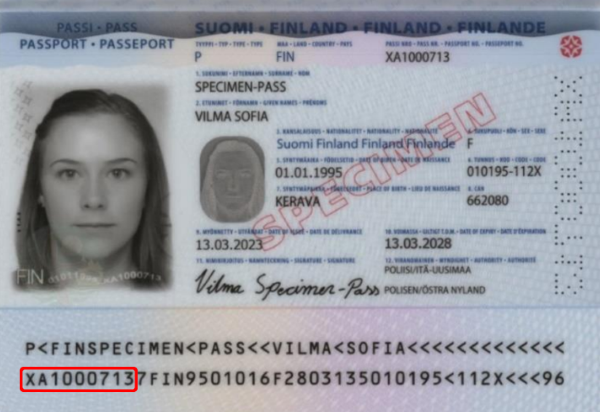
The biometric EU/EEA identity card number may be located in different fields on different national identity cards. The biometric EU/EEA identity card number is typically located in the field labeled "Document number" or "Card number", but it can also be located in other fields. You can verify the correct identity card number from the machine-readable zone (MRZ) on the reverse side of the identity card. The identity card number is located on the first line of the MRZ, starting from the 6th character, see the picture below.
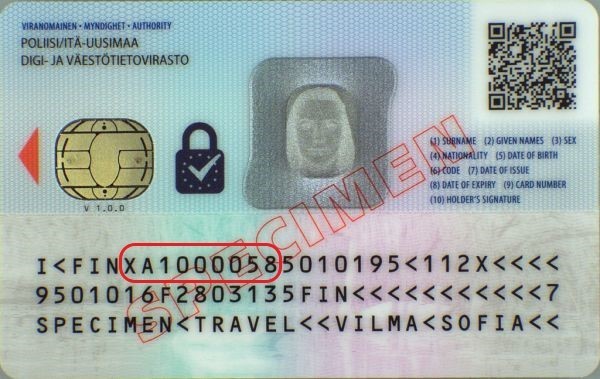
Exam sections, duration and scoring
The entrance exam is conducted in the English language. The exam sections and duration of the exam are determined on the basis of the study programmes you apply for. You complete at one time all the exam sections that are included to the study programmes you apply for. The entrance exam includes both common exam sections to all study programmes and field-specific exam sections. The exam sections for each study field are presented in Chart 1. A total score of the exam is the sum score of the exam sections included to your study programme. In order to be selected, you must pass all the exam sections (i.e. reach the minimum pass score per section).
A specific response time has been allocated for each exam section. When the section-specific time is up, the section will close. If you don’t finish the section, its latest version will be saved as your answer. You can complete the sections in any order. However, please note that once a section is opened, it needs to be completed, and you cannot return to the section later. In addition to the section-specific times, there is 15 minutes for transitions between sections in the exam.
Common exam sections to all study programmes:
- Reasoning skills (25 minutes): You have to complete this exam section regardless of the programme you apply for. The section assesses your logical reasoning and problem-solving skills. Please have a look at the reasoning skills example questions.
- English language skills (20 minutes): You have to complete this exam section regardless of the programme you apply for. The section assesses your skills in reading and interpreting texts, such as understanding the relation between different parts of the text, mastering vocabulary and linguistic reasoning. Please have a look at the English language skills example questions.
Field-specific exam sections:
- Mathematical skills (25 minutes): This exam section is required for the fields of Technology, Business Administration and BIT, Natural Resources, Tourism and Hospitality, Seafaring, Social Services, Health Care, Sports and Exercise and Beauty Care. The contents of the section are the same for all the above-mentioned fields. In this section, your basic mathematical skills are assessed. The focus is on basic calculations, calculating percentages, first-degree equations, geometry, mathematical-logical reasoning and interpreting tables, graphs and diagrams. In this section, you are allowed to use the function calculator of the examination system. Do not use any other calculators, calculator applications, or calculator functionalities. Using such tools may result in your exam result being rejected. Please have a look at the mathematical skills example questions.
Introduction
The test system calculator is available when you are allowed to use a calculator to complete tasks. In sections where the calculator is available, the Calculator button appears on the right-hand side of the applicant's view. The calculator is opened by clicking the button. The calculator can also be opened and closed using a keyboard shortcut or the keyboard.
Calculator’s functions in the exam system:
- addition, subtraction, multiplication and division
- brackets
- squares and square roots
- power of ten and general power
- trigonometric functions (angle values in degrees)
- natural logarithm (ln) and common logarithm (log)
- constant numbers π and e
- result of the previous calculation in the ANS button
- storing the value of an expression in memory Min and reading the value from memory Mout
Using the calculator
Opening and closing the calculator during the exam The calculator can be opened by clicking the Calculator button on the right-hand side of the applicant's view (or by pressing Ctrl + Shift + L or Cmd + Shift + L). The calculator can be hidden by clicking the x symbol on the left-hand side of the open calculator (or by pressing Ctrl + Shift + L or Cmd + Shift + L). The buttons for opening and closing the calculator can also be accessed using the keyboard (tab navigation).
Hiding the calculator does not delete the calculation on the calculator screen. Calculations can be partially entered using the keyboard.
Entering expressions and performing calculations
Expressions can be entered in three different ways:- Using the computer keyboard
- The Pi (π) and square root (√) symbols cannot be entered using the keyboard
- Expressions are executed by pressing Enter when the focus is on the input field
- The input field is cleared with the Esc key (corresponds to the AC button on a calculator)
- Exponentiation with the ^ symbol, input example: 5^2
- Inputting the functions sin, cos, tan, asin, acos, atan, ln and log, for example: sin(30) and atan(1)
- By clicking the calculator buttons with the mouse
- The selected symbols are added to the expression in the input field
- The expression is executed by clicking the equal sign
- By navigating with the arrow keys on the computer keyboard
- Switching between the input field and the calculator keyboard: tab / shift-tab
- Confirm your selection with the enter button
- The expression is executed by navigating to the equal sign and pressing enter
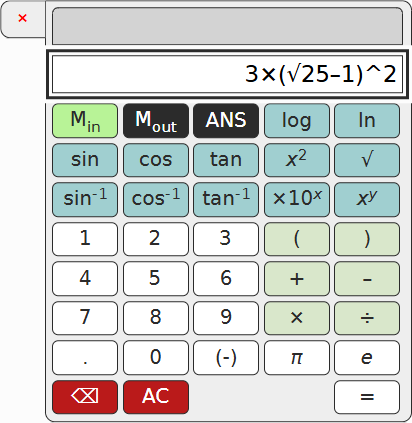
After executing the expression, the input is transferred to the top row of the calculator and the result to the bottom row.
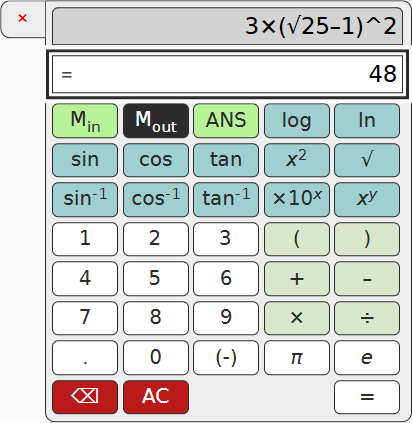
After the calculation, it is possible to- Start entering a new expression. The expression and result are deleted when you start typing a new entry. If the entry after ‘=’ starts with:
- the operators +, -, /, * or an exponent: ANS(*) and the entered operation are recorded as the entry. E.g. + → ANS+.
- Note: the symbol ‘-’ entered on the keyboard is interpreted as a prefix in the new expression, not as an operator!
- another symbol: the expression is replaced with the entered symbol. E.g. 5 → 5 or cos → cos(
- the operators +, -, /, * or an exponent: ANS(*) and the entered operation are recorded as the entry. E.g. + → ANS+.
- Return the calculated/executed expression for editing by clicking on the expression. The expression is transferred to the input field. Alternatively, you can return the expression by navigating to the relevant field using the keyboard (shift+tab) and pressing enter.
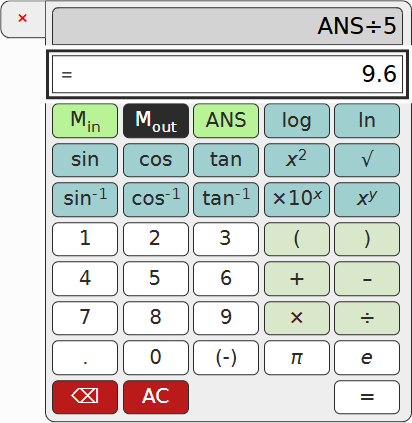
- Advanced mathematical skills (30 minutes): This exam section is required for the field of Technology. The section assesses your abilities in mathematics and physics. Your mathematical skills are assessed by questions related to reducing rational expressions, solving equations, level geometry and trigonometry (e.g. right-angled triangle). Your physics skills are assessed by questions related to basic knowledge in physical phenomena and calculation formulas, your ability to calculate and reason on the basis of basic physical knowledge and given models, and your ability to interpret charts, graphs and diagrams. In this section, you are allowed to use the function calculator of the examination system. Do not use any other calculators, calculator applications, or calculator functionalities. Using such tools may result in your exam result being rejected. Please have a look at the advanced mathematical skills example questions.
Introduction
The test system calculator is available when you are allowed to use a calculator to complete tasks. In sections where the calculator is available, the Calculator button appears on the right-hand side of the applicant's view. The calculator is opened by clicking the button. The calculator can also be opened and closed using a keyboard shortcut or the keyboard.
Calculator’s functions in the exam system:
- addition, subtraction, multiplication and division
- brackets
- squares and square roots
- power of ten and general power
- trigonometric functions (angle values in degrees)
- natural logarithm (ln) and common logarithm (log)
- constant numbers π and e
- result of the previous calculation in the ANS button
- storing the value of an expression in memory Min and reading the value from memory Mout
Using the calculator
Opening and closing the calculator during the exam The calculator can be opened by clicking the Calculator button on the right-hand side of the applicant's view (or by pressing Ctrl + Shift + L or Cmd + Shift + L). The calculator can be hidden by clicking the x symbol on the left-hand side of the open calculator (or by pressing Ctrl + Shift + L or Cmd + Shift + L). The buttons for opening and closing the calculator can also be accessed using the keyboard (tab navigation).
Hiding the calculator does not delete the calculation on the calculator screen. Calculations can be partially entered using the keyboard.
Entering expressions and performing calculations
Expressions can be entered in three different ways:- Using the computer keyboard
- The Pi (π) and square root (√) symbols cannot be entered using the keyboard
- Expressions are executed by pressing Enter when the focus is on the input field
- The input field is cleared with the Esc key (corresponds to the AC button on a calculator)
- Exponentiation with the ^ symbol, input example: 5^2
- Inputting the functions sin, cos, tan, asin, acos, atan, ln and log, for example: sin(30) and atan(1)
- By clicking the calculator buttons with the mouse
- The selected symbols are added to the expression in the input field
- The expression is executed by clicking the equal sign
- By navigating with the arrow keys on the computer keyboard
- Switching between the input field and the calculator keyboard: tab / shift-tab
- Confirm your selection with the enter button
- The expression is executed by navigating to the equal sign and pressing enter

After executing the expression, the input is transferred to the top row of the calculator and the result to the bottom row.

After the calculation, it is possible to- Start entering a new expression. The expression and result are deleted when you start typing a new entry. If the entry after ‘=’ starts with:
- the operators +, -, /, * or an exponent: ANS(*) and the entered operation are recorded as the entry. E.g. + → ANS+.
- Note: the symbol ‘-’ entered on the keyboard is interpreted as a prefix in the new expression, not as an operator!
- another symbol: the expression is replaced with the entered symbol. E.g. 5 → 5 or cos → cos(
- the operators +, -, /, * or an exponent: ANS(*) and the entered operation are recorded as the entry. E.g. + → ANS+.
- Return the calculated/executed expression for editing by clicking on the expression. The expression is transferred to the input field. Alternatively, you can return the expression by navigating to the relevant field using the keyboard (shift+tab) and pressing enter.

- Ethical skills (10 minutes): This exam section is required for the fields of Social Services, Health Care, Sports and Exercise, Beauty Care, and Humanities and Education. The contents of the section are the same for all the above-mentioned fields. In this section, your skills in recognising the ethical nature of statements are assessed. Please have a look at the ethical skills example questions.
- Emotional intelligence skills (10 minutes): This exam section is required for the fields of Social Services, Health Care, Sports and Exercise, Beauty Care, and Humanities and Education. The contents of the section are the same for all the above-mentioned fields. In this section, your capabilities in emotional intelligence skills, such as recognizing and controlling emotions, are assessed. Please have a look at the emotional intelligence skills example questions.
Chart 1. Exam sections.
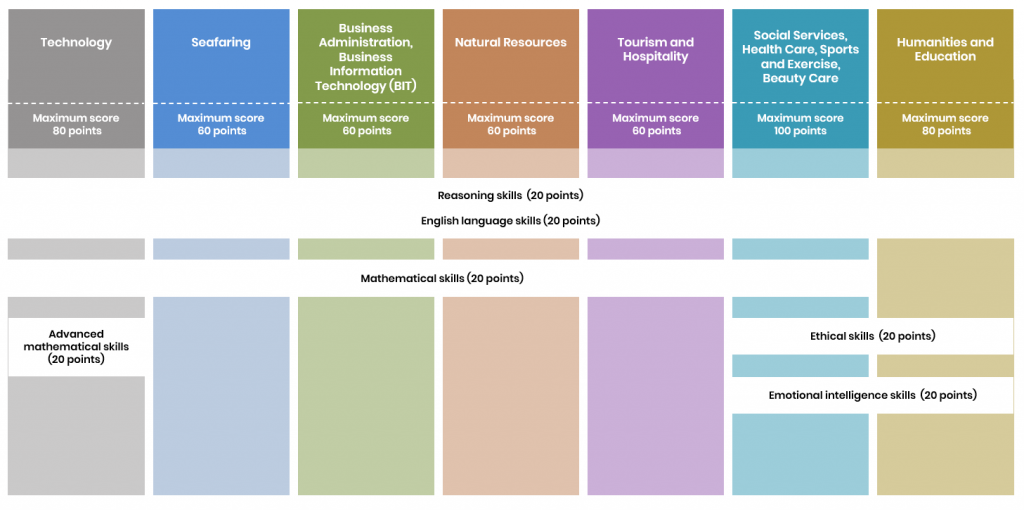
Identification
Note: Information will be updated for spring 2026.
Monitoring
Note: Information will be updated for spring 2026.
Instructions for using an external camera
Note: Information will be updated for spring 2026.
Guidelines for exam completion
Note: Information will be updated for spring 2026.
Participating in the exam and exam schedule
Note: Information will be updated for spring 2026.
Hardware and network requirements
Note: Information will be updated for spring 2026.
Note: Hardware requirements are subject to updates; please check the detailed instructions before participating in the exam.
Privacy policy
The applicant performs the pre-identification in the Candour ID application. If the applicant does not succeed with the pre-identification in the Candour ID application, their pre-identification will be forwarded for manual review. In the manual process, the applicant’s pre-identification data is reviewed by Vallu entrance examination service operators and, based on this review, the applicant’s pre-identification is either approved or rejected. During the pre-identification, Candour forwards the facial image of the applicant to Vallu entrance examination service. In the identification on the exam day, the selfie taken by the applicant is compared to the facial image stored during the pre-identification. The purpose of identification is to verify the applicant’s identity. The data collected during the exam will be stored only for the necessary time period after the exam. Collecting and storing data is compatible with the European General Data Protection Regulation (GDPR). The servers are located in the European Union.
Vallu entrance examination service forwards the applicant’s name and email address, and the facial image of the applicant captured during the pre-identification to SMOWLtech via a technical interface. The facial image is used in SMOWL proctoring software as a registration image and during the exam as a reference image for SMOWL monitoring, against which images taken by the frontal camera and external camera during monitoring are compared.
SMOWL CM proctoring software stores frontal camera and external camera images, screenshots of applicant’s computer screen, audio recordings, and all computer activities during the exam, including visited websites and opened applications. The purpose of monitoring is to ensure that the applicant completes the exam independently, without the help of anybody or anything. Monitoring is conducted automatically during the exam to secure legal protection and parity of applicants. The applicant may refuse monitoring or interrupt it. Refusing or interrupting monitoring means that the applicant may not be selected by the International UAS Exam selection method. After the exam, the applicants’ monitoring data is reviewed by Vallu entrance examination service operators and, based on this review, applicants may be dismissed if they have acted contrary to the guidelines for exam completion. The data stored during the entrance exam will be stored only for the necessary time period after the entrance exam. Collecting and storing data is compatible with the EU’s General Data Protection Regulation (GDPR). The servers are located in the European Union.
- More information on Candour’s privacy policy
- More information on SMOWL’s privacy policy
- More information on Vallu entrance examination service’s privacy policy
Frequently Asked Questions about the International UAS Exam
Note: Information will be updated for spring 2026.
Individual arrangements
Note: Information will be updated for spring 2026.
Individual arrangements refer to customized practical arrangements in an entrance examination situation. You may be granted individual arrangements due to illness, disability, dyslexia, or some other specific reason.
If, due to disability, disease, dyslexia or some other specific reason, you need individual arrangements during the entrance exam (e.g. additional time, tasks without pictures for applicants using a screen reader), you have to fill in a written request for individual arrangements. Please attach a medical certificate or other equivalent attestation on the nature of your disability or disease. The statement should clearly state why you need individual arrangements and explicitly detail the type of individual arrangements recommended for you. The applicants’ situations are assessed on a case-by-case basis.
Final student selection and publishing the results of International UAS Exam
Final selection of students is done on the basis of the total score of the International UAS Exam. A total score of the exam is the sum score of the exam sections included to your study programme. Applicants who do not meet the programme-specific eligibility criteria will not be selected as students.
The results will be published on 15 April 2026 at the latest. You may view your scores in Studyinfo service. You may also be admitted from the waiting list on 4 August 2026 at the latest. Your exam scores will remain valid only for the application round in question.
The questions and the right answers of the exam will not be published. The International UAS Exam is deemed a secret official document based on the Act on the Openness of Government Activities, Section 24(22).
Entrance Exam Score Service
Note: Information will be updated for spring 2026.
